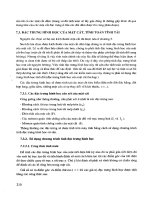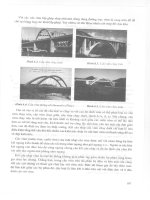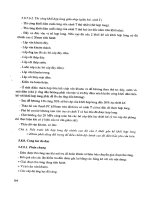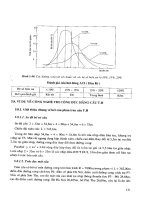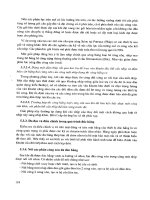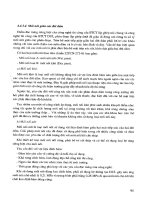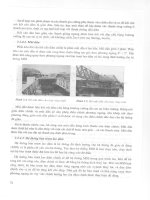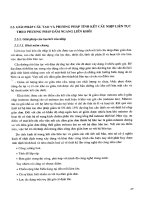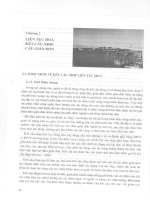Tiếng anh chuyên ngành xây dựng phần Bê Tông toàn khối
Bạn đang xem bản rút gọn của tài liệu. Xem và tải ngay bản đầy đủ của tài liệu tại đây (106.64 KB, 5 trang )
Construction Engineering 1 Construction technology of monolithic reinforced concrete
PHN B: CễNG NGH THI CễNG Bấ TễNG TON KHI (30T)
Part B: Construction technology of monolithic reinforced concrete
Ch ơng 7: Những khái niệm về công nghệ thi công công trình bê tông cốt thép đổ tại chỗ
Chapter 7: Definitions of construction technology of cast-in-place monolithic reinforced concrete
Ch ơng 8: Công tác ván khuôn
Chaper 8: Formwork
Ch ơng 9: Công tác cốt thép
Chapter 9: Steel reinforcing works
Ch ơng 10: Công tác bê tông
Chapter 10: Concrete works
Division of Construction Technology and Management NUCE
113
Construction Engineering 1 Construction technology of monolithic reinforced concrete
CHNG 7: NHNG KHI NIM V CễNG NGH THI CễNG CễNG
TRèNH Bấ TễNG CT THẫP TI CH (2T)
Chapter 7: Definitions of construction technology of cast-in-place monolithic
reinforced concrete
Bài 25 - Bản chất của công nghệ bê tông cốt thép đổ tại chỗ - Ưu nh ợc điểm và phạm vi ứng dụng
Unit 25 Natures of construction technology of cast-in-place reinforced concrete Advantages,
disadvantages and application
Bài 26 - Dây chuyền công nghệ thi công bê tông cốt thép đổ tại chỗ - đặc điểm của các dây chuyền
bộ phận và những giai đoạn kỹ thuật
Unit 26 Production line of construction technology of cast-in-place reinforced concrete
features and technical phases
BI 25: BN CHT CễNG NGH Bấ TễNG CT THẫP TI CH
Division of Construction Technology and Management NUCE
114
Construction Engineering 1 Construction technology of monolithic reinforced concrete
Unit 25: Natures of construction technology of cast-in-place reinforced concrete
1. Khái niệm/Definition
- Bê tông cốt thép (BTCT) theo TCXD 191-1996 là hỗn hợp đóng rắn của các vật liệu gồm
chất kết dính, cốt liệu lớn, cốt liệu nhỏ và nớc, có thể có phụ gia hoặc không.
Reinforced concrete according to TCXD 191-1996 is defined as the harsh mixture of
materials including binding agent, large and small coarse aggregate and water, neither or
not addtitve.
- Vì BT chịu nén tốt và chịu kéo kém nên để khắc phục khả năng chịu kéo của bê tông, ta
đặt cốt thép vào vùng chịu kéo của bê tông. Bê tông có đặt cốt thép gọi là bê tông cốt thép.
Because of the compressible capacity of concrete and in order to improve its tensible
capacity, reinforcing robs is placed in tensible areas of concrete structures. These
structures are called reinforced concrete.
- Các kết cấu bằng BT hay BTCT đợc thi công theo 2 phơng pháp : phơng pháp đổ bê tông
toàn khối hoặc phơng pháp lắp ghép.
Concrete or reinforced concrete structures are built according to two methods: monolithic
(cast-in-place) or precast
Phơng pháp đổ bê tông toàn khối: Các cấu kiện đợc đúc trực tiếp tại các vị trí trên
công trình.
Monolithic method: concrete components are made directly in construction site.
Phơng pháp lắp ghép: Các cấu kiện đợc đúc tại các xí nghiệp, nhà máy hoặc tại các
bãi đúc trên công trờng, sau đó chúng đợc vận chuyển đến nơi xây dựng, rồi dùng
cần trục để lắp ghép vào công trình.
Precast method: concrete components are produced at firms, plants or precast areas
of construction site, then they are delivered to construction site and built up by
cranes.
2. Các u, nhợc điểm của công nghệ thi công bê tông toàn khối/ Advantages and
disadvantages of construction technology of cast-in-place concrete
- Ưu điểm/ advantages
Kết cấu có độ cứng lớn, chịu lực động tốt.
Structures are stiff and able to bear live loads.
Có thể đúc đợc các kết cấu có hình dạng kích thớc bất kỳ tùy theo yêu cầu kiến
trúc.
Can produce structures with diffirent shapes according to architecture
requirements.
Cốt liệu để chế tạo BT nh đá, sỏi, cát có sẵn tại các địa phơng cần xây dựng.
Coarse aggregate such as stones, gravels, sands are available.
Division of Construction Technology and Management NUCE
115
Construction Engineering 1 Construction technology of monolithic reinforced concrete
Có thể chế tạo đợc nhiều loại BT có cờng độ khác nhau từ 100 - 400 K/cm2, với
trọng lợng riêng từ 2000 - 2500 Kg/cm3.
Can produce a wide range of concrete with different strength from 100 to 400
kG/cm2 and unit weight from 2000 to 2500 kG/cm3
Có thể chế tạo các lọai BT có những đặc tính khác nhau nh BT chống thấm, bê tông
chịu ăn mòn, bê tông cách nhiệt, cách âm.
May produce a wide range of concrete with different features such as impermeable
concrete, corrosion-resistant concrete, head and sound insulating concrete
Có thể cơ giới hóa trong khi thi công.
Can mechanize construction works
Giá thành thấp hơn so với các kết cấu khác nh thép.
Cheaper than other structures such as steel structures.
- Nhợc điểm/ Disadvantages
Thời gian chờ để kết cấu chịu đợc lực là khá lâu
Curing time of concrete structures is long
Việc thi công phụ thuộc nhiều vào điều kiện thời tiết.
Construction works depend on weather conditions
Các kết cấu có hình dáng to, trọng lợng nặng.
Concrete structures are normally large and heavy
Tốn kém các vật liệu để làm ván khuôn, cột chống
Cost for materials to made formwork, shores, etc
3. Phạm vi áp dụng/ Application
Công nghệ thi công BTCT toàn khối đợc áp dụng rộng rãi trong thi công các công trình
dân dụng, công nghiệp, thủy lợi Các công trình đặc biệt nh xilô, ống khói.
This technology is used widely in civil, industry and irrigation construction, etc and
special construction works such as silo, chimney.
BI 26: DY CHUYN CễNG NGH THI CễNG Bấ TễNG CT THẫP
TI CH
Division of Construction Technology and Management NUCE
116
Construction Engineering 1 Construction technology of monolithic reinforced concrete
Unit 26: Production line of construction technology of cast-in-place
reinforced concrete
1. Dây chuyền công nghệ thi công BTCT đổ tại chỗ/ Production lines of construction
technology of cast-in-place reinforced concrete
Dây chuyền ván khuôn/ formwork
Dây chuyền cốt thép/ steel reinforcing works
Dây chuyền đổ bê tông/ pouring concrete works
2. Đặc điểm các dây chuyền bộ phận
2.1. Dây chuyền ván khuôn/ formwork
- Là dây chuyền đợc thực hiện đầu tiên và sau khi đổ bê tông xong.
Carried out first and after pouring concrete.
- Gồm các công tác gia công, chế tạo lắp dựng và tháo dỡ ván khuôn , xà gồ, cột chống và
sàn thao tác.
Composed of handling works, erection, dismantlement of formwork, bearers, shores and
working platforms.
- Là dây chuyền quyết định tới hình dáng, kích thớc và ảnh hởng tới chất lợng cấu kiện
BTCT.
Important to decide shape, dimentions and quality of reinforced concrete structures.
2.2. Dây chuyền cốt thép/ steel reinforing works
- Đợc thực hiện sau khi dây chuyền ván khuôn kết thúc (sau phân đọan đầu tiên)
Carried out after finishing the formwork phase (after the first section)
- Gồm các công tác: nắn thẳng, đánh gỉ, cắt, uốn và lắp dựng.
Composed of works: straighthening, scaling, cutting, bending and erecting
2.3. Dây chuyền bê tông/ concrete works
- Đợc thực hiện sau dây chuyền cốt thép kết thúc (sau phân đọan đầu tiên).
Carried out after finishing steel reinforcing works (after the first section)
- Gồm các công tác: trộn, vận chuyển, rải vào khuôn, đầm và bảo dỡng bê tông.
Composed of works: mixing, delivering, spreading into forms, vibrating and curing
2.4. Những gián đoạn kỹ thuật/ technical discontinuity
Có 2 giai đoạn cơ bản/ there are two stages:
- Gián đọan chờ đợi đến khi đợc phép dựng dàn giáo ván khuôn trên các kết cấu vừa mới đổ
bê tông
Waiting time until scaffold and formwork systems can be erected on the previous
concrete-poured structures.
- Gián đoạn chờ đợi bê tông đủ cờng độ để có thể tháo dỡ đợc ván khuôn.
Waiting time until concrete strength are enough to dismantle formwork system
Division of Construction Technology and Management NUCE
117
